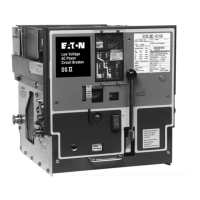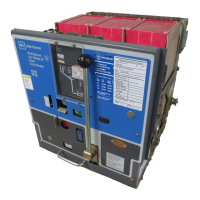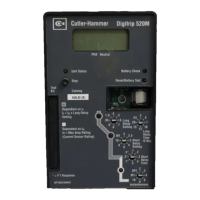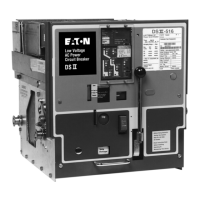Page
18
FRONT
(Close Springs Removed)
Levering Shaft
Interlock
Emergency
Charge Return
Spring
Hold Pawl
l.B.
694C694-02
Spring Anchor
REAR
Figure 3-13 Typical Front/Rear Views
of
Power Operated Spring Charge Mechanism
The drawout manually operated circuit breaker has four
normal positions
in
its compartment, determined by the
levering device: REMOVE, DISCONNECT, TEST AND
CONNECT. Refer to Paragraph 2-5 for additional infor-
mation.
3-8.2 POWER OPERATED CIRCUIT BREAKER
On power operated circuit breakers, the closing springs
can be charged both electrically and manually.
Normally, the springs are automatically charged by a
universal type electric motor, which is part of the mecha-
nism. If necessary, the springs can be charged manually
through the use of a front mounted spring-charge han-
dle. The spring charge handle used with power operated
circuit breakers is significantly shorter than the handle
used with manually operated circuit breakers. Closing is
accomplished electrically by an electromagnet which
lifts the closing spring release latch. Like the manually
operated circuit breaker, the power operated circuit
breaker can also be closed manually by pushing on the
front control panel close bar (Figure
3-3).
Like the manually operated version, the power operated
circuit breaker can also be tripped open manually by
pushing the trip plate
on
the front control panel
or
the
trip plate on the circuit breaker compartment door.
Power operated circuit breakers can be electrically
tripped through the following devices:
• Standard shunt trip device
• Trip actuator energized from the electronic trip unit
• Optional undervoltage trip device
• Blown limiter indicator on DSLll type breakers
3-9 MOVABLE PRIMARY AND SECONDARY
CONTACTS
The primary connection of a drawout circuit breaker to
the primary stabs
in
the breaker compartment is provid-
ed by six primary disconnect finger clusters (Figures
3-1
and 3-2). Each finger cluster is comprised of a number
of spring loaded fingers. The number of fingers varies,
depending upon the current rating of the breaker. Finger
clusters attach to the primary studs of the breaker's pole
unit assembly. Finger clusters can be easily removed
using a finger cluster removal tools.
Effective
07
/97
Courtesy of NationalSwitchgear.com

